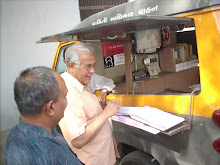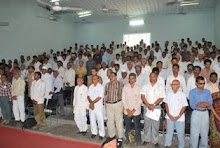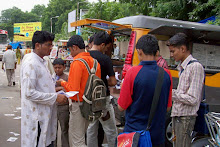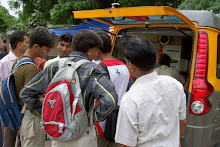The New Indian Express: Chennai: Sunday, 03 August
2014.
It is 6.30am
at the Kasimedu beach in Chennai. As the darkness slowly peels off, the waves
pummel the shore noisily, only to be eclipsed by a sound louder and more
powerful, primordial even—that of the conch. Around 40 people, including
children, holding conches to their mouths blow with vigour, enveloping
everything around them—the shore, the sand, the sea. It continues thus for a
few hours, with the group only pausing in between to breathe.
When it ends,
a few of them have tears in their eyes and some shiver. One or two walk up to
Jagasundari and her husband Siva Balamurugan—the brains behind the conch
training initiative—and say that they feel like new people.
It was in
December 2013 that Jagasundari, 32, and Siva, 40, started the Vavivudaimanikkam
Sangnatha Trust with just 10 members. Today, they train nearly 100 people to
blow the conch for free.
It had all
started in 2001, when Siva, a corporation employee, who was always intrigued by
conches being blown in temples, decided to try it himself. Since then there has
been no stopping him. Eventually, his wife Jagasundari also came to share his
passion. “We blow conches during pradoshams and kumbabhishegams in temples. We
go to all Lord Siva and Goddess Amman temples around Tamil Nadu to blow
conches,” shares Jagasundari.
Everything
was going great until 2012, when one day they were asked to stop blowing the
conch in a temple in Thiruvattriyur by the HR&CE assistant commissioner.
“We were surprised that they found it to be a bad omen. According to
scriptures, conch should be blown on three occasions—at birth, during a
marriage and at death. Nowadays, it is only done at funerals,” says
Jagasundari, explaining why conch blowing has become a symbol of mourning.
“When the soul goes out, it never accepts that the body is dead and tries to
enter back. This causes a negative effect on the body and others around. To
combat this evil, we blow shells,” she explains.
Apparently,
in the past conches were blown to mark any auspicious moment be it a marriage
ceremony or to announce the arrival of a king. “Lord Krishna has a conch,
Panchajanyam, as a weapon, so do other gods. All our scriptures refer to
conches as positive, then why is it considered negative? Because people aren’t
aware of ancient traditions,” says Siva, the president of the trust.
“The incident
at the temple was in fact the turning point for us,” says Jagasundari, who is a
lawyer. “We filed an RTI asking if there was any rule that conches shouldn’t be
blown in public places. There was no rule,” she says. And now they have asked
the government to grant a customary right (under Section 63 (e) of HR & CE
Act 1969) to make conch blowing legal for all. While they are yet to hear from
the state on this matter, they continue to have their classes every Sunday from
3pm to 6pm in Kasimedu Fishing Harbour. “People from as far as Vellore come for
our classes. Once they learn from us, they teach others,” says Siva.
The class
begins with pranayama or breathing exercises. This is followed by chanting a
mantra associated with the conch. “Then we teach them a little about the conch
and how to hold it,” says Jagasundari. The different positions bring out
different sounds. And to reach the highest decibel one has to completely face
upwards and blow. “This is tough for a beginner. One can do it only after days
of practice,” she says.
Those who
practice it regularly have seen significant physiological and psychological
changes, says the couple. “It instills confidence in the shy, strengthens one’s
will power and brings out courage,” says Siva. “It helps cure stammer, bronchitis
and other lung problems,” says Jagasundari.
“Conch
blowing is about spreading positive vibrations,” says Jagasundari. Her class
includes people with intellectual disabilities, heart patients and even people
from other religions.
The couple is
now preparing to enter the Guinness Book of Records by having 200 people blow
conches simultaneously. They have 30 conches so far and plan to acquire the
remaining through funds.














































































